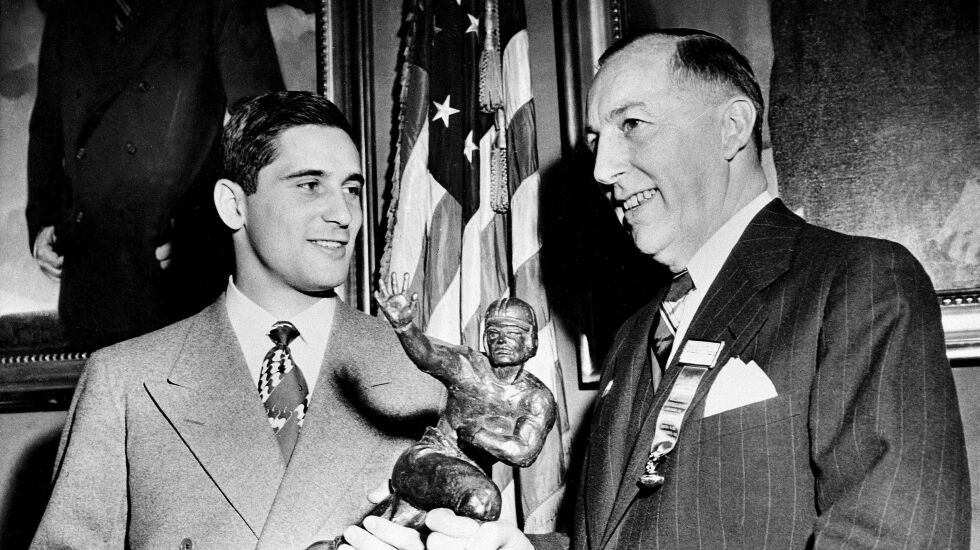
Legendary Notre Dame quarterback Johnny Lujack was a link to a Bears era that today’s fans probably find incomprehensible — when the Bears had too many good quarterbacks.
Lujack, the 1947 Heisman Trophy winner at Notre Dame who died in Florida on Tuesday at 98 after a brief illness, was a rookie on the 1948 Bears, with future Hall of Famers Sid Luckman and Bobby Layne.
Lujack and Luckman would share quarterback duties — with Layne pitching in — as the Bears went 10-2. Lujack also led the Bears with eight interceptions as a defensive back.
With Lujack the heir apparent to Luckman, Bears owner George Halas sold Layne to the New York Bulldogs in 1949 — and signed George Blanda, another future Hall of Famer. (Layne later led the Lions to NFL championships in 1952 and 1953 on his way to the Hall of Fame.)
Lujack became the Bears’ primary quarterback in 1949 and led the NFL with 2,658 yards (221.5 per game) and 23 touchdowns as the Bears went 9-3. He threw for 468 yards and six touchdowns in a 52-21 victory over the Chicago Cardinals.
Lujack played two more seasons for the Bears — making the Pro Bowl in 1950 and 1951 — before retiring at 26 after the 1951 season. With Halas still stocking up on quarterbacks — Steve Romanik, Bob Williams and Ed Brown — Lujack became unhappy with his role and left the Bears to coach under Leahy at Notre Dame in 1952 and continue his offseason job as an insurance salesman in Chicago.
In 1950, Lujack rushed for 11 touchdowns — an NFL record for a quarterback at the time and still a franchise record today. He also was a punter and place-kicker, making 130-of-136 PATs and 4-of-9 field goals.
At Notre Dame, Lujack was a storied All-American in every sense of the honor. He led Notre Dame to a national championship under Frank Leahy in 1943, served two years in the Navy during World War II, then returned to Notre Dame and led the Irish to national championships under Leahy in 1946 and 1947. He was 20-1-1 as a starter in Notre Dame.
Lujack’s death was confirmed by his granddaughter, Amy Schiller, who said he had entered hospice care recently after having been in good health until a couple of weeks ago.
“He was not only a legend in Notre Dame football and the sports world,” Schiller said, “he was a legend as a father and grandfather and great grandfather.”
While Lujack had plenty of offensive highlights at Notre Dame, he is best remembered for a play he made as a defensive back in an era when players stayed on the field for nearly every play.
A standing-room-only crowd of about 75,000 packed Yankee Stadium in 1946 to see No. 1 Army — the two-time defending national champions — face then-rival Notre Dame, which was ranked No. 2. Lujack made the game-saving tackle against Doc Blanchard in a 0-0 tie. That contest is frequently referred to as the game of the century.
Lujack, in a 1996 interview with the AP, said that was the game he was asked about most often. He downplayed the tackle of Blanchard, who won the Heisman in 1945.
“You were back there,” Lujack said. “You were supposed to make the tackle.”
Lujack finished third in Heisman voting in 1946 before he won the award as the college game’s outstanding player the next year, when he completed 61 of 109 passes for 777 yards with nine touchdowns in leading the Irish to a 9-0 record and their second straight title.
He took over as the starting quarterback for the top-ranked Irish in 1943, after Angelo Bertelli left after six games to join the Marines. Among the other Irish greats he played with were Creighton Miller, Terry Brennan, Emil Sitko, George Connor, Bill Fischer and 1949 Heisman winner Leon Hart.
“We always felt that a game was kind of an easy scrimmage because the scrimmages we had against each other were mean and rough,” Lujack once said.
The one loss in his college football career came in the final game of his sophomore season against Great Lakes Naval Training Station, a military base team that had some college players serving in the military, including some Notre Dame players.
Lujack intercepted eight passes as a rookie with the Bears and in 1949 he threw for 468 yards and six touchdowns in a 52-21 win over the Chicago Cardinals. He played in the Pro Bowl his final two seasons before retiring.
He served as an assistant coach at Notre Dame in Leahy’s final two seasons. He then moved to Davenport, Iowa, where he owned an auto dealership until 1988.
Contributing: Associated Press







